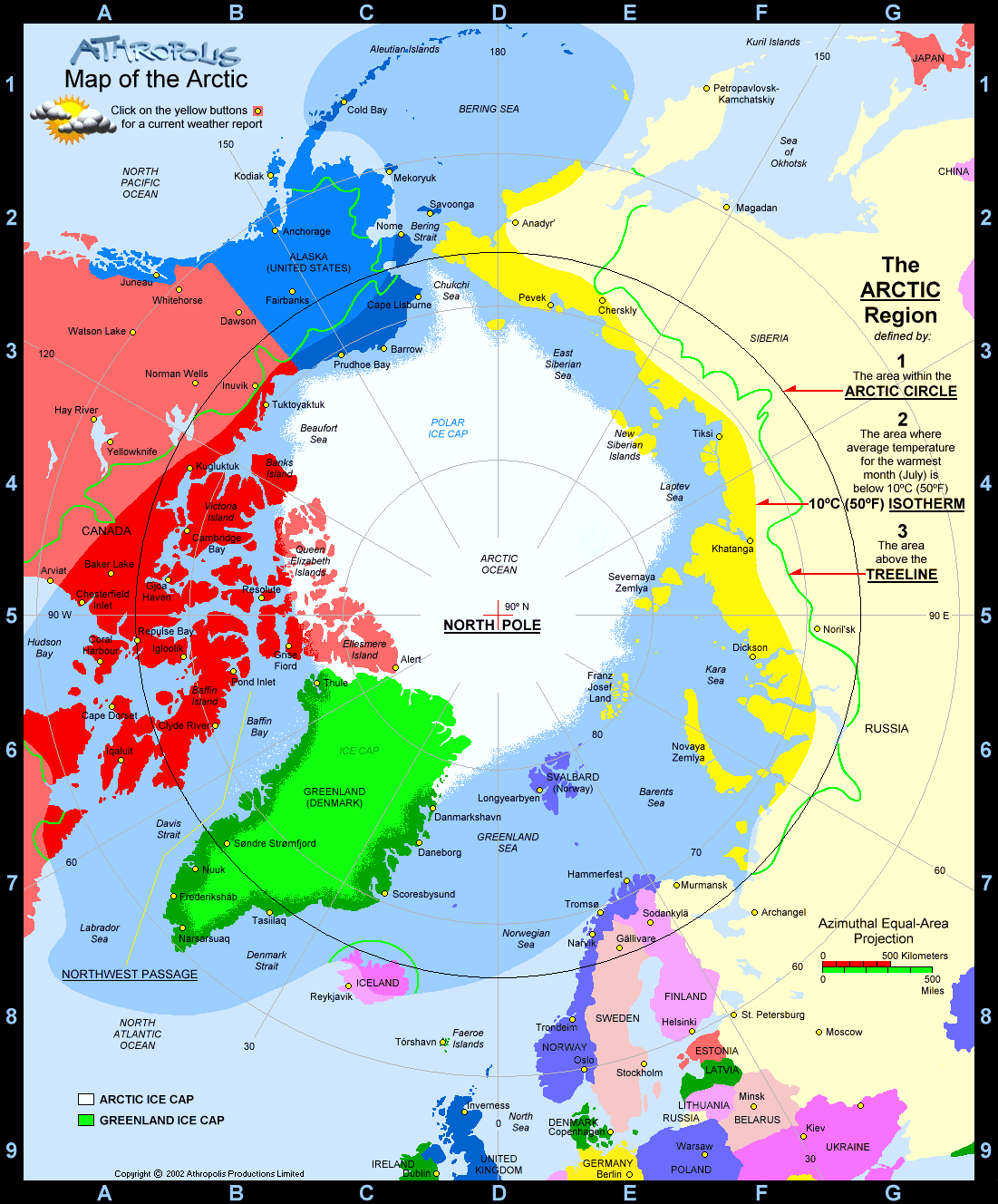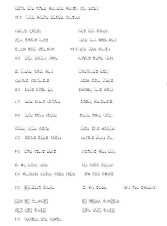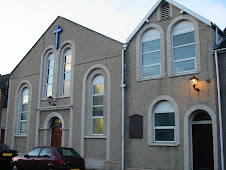3/30/2008
Arctic Tale: Arctic Cap will melt completely by 2040!
![]() Labels:
Global warming,
icebergs,
movie,
the Arctic
at
10:45 AM
0
comments
Labels:
Global warming,
icebergs,
movie,
the Arctic
at
10:45 AM
0
comments
3/25/2008
Enjoy . Move forward .
Dear KB
It is my birthday tomorrow lar.... another year has passed...
I don't know if I am moving forward at all....
I wish I am more productive la...
I want to enjoy the process of doing homework and assignments... and this is my birthday wishes... 
otherwise why should I do any more of these degrees..?
They are the process and life through which I grow, I reflect, and take the opportunity to learn and add on to become a pastoral psychologist....
I get a bit lost these days....
I feel that I still have such a long road to go and even though I have room and time to move forward, I fail to make a move...
Maybe I should join you guys for some badminton or some sports.....
I feel so happy to hear about your fruitful Easter holiday! I had 4 full days of workshop ah...It is good to go through all these, good or bad, under God's love...
I feel very distant from everything, everybody these days... even when I am with others...
I do feel more close to you. Maybe both of us feel that God is in charge even though we don't understand everything. %20Rod%20Boothby%202005.jpg)
Love,
Gal
![]() Labels:
Diary,
My birthday
at
8:18 PM
2
comments
Labels:
Diary,
My birthday
at
8:18 PM
2
comments
World Map of Internet Country Codes
Source: VisiBone Country Chart
The world's first map of internet country codes.Phone codes too, alphabetic and numeric lists.Look up four ways: code, name, location, or phone.
Click for full version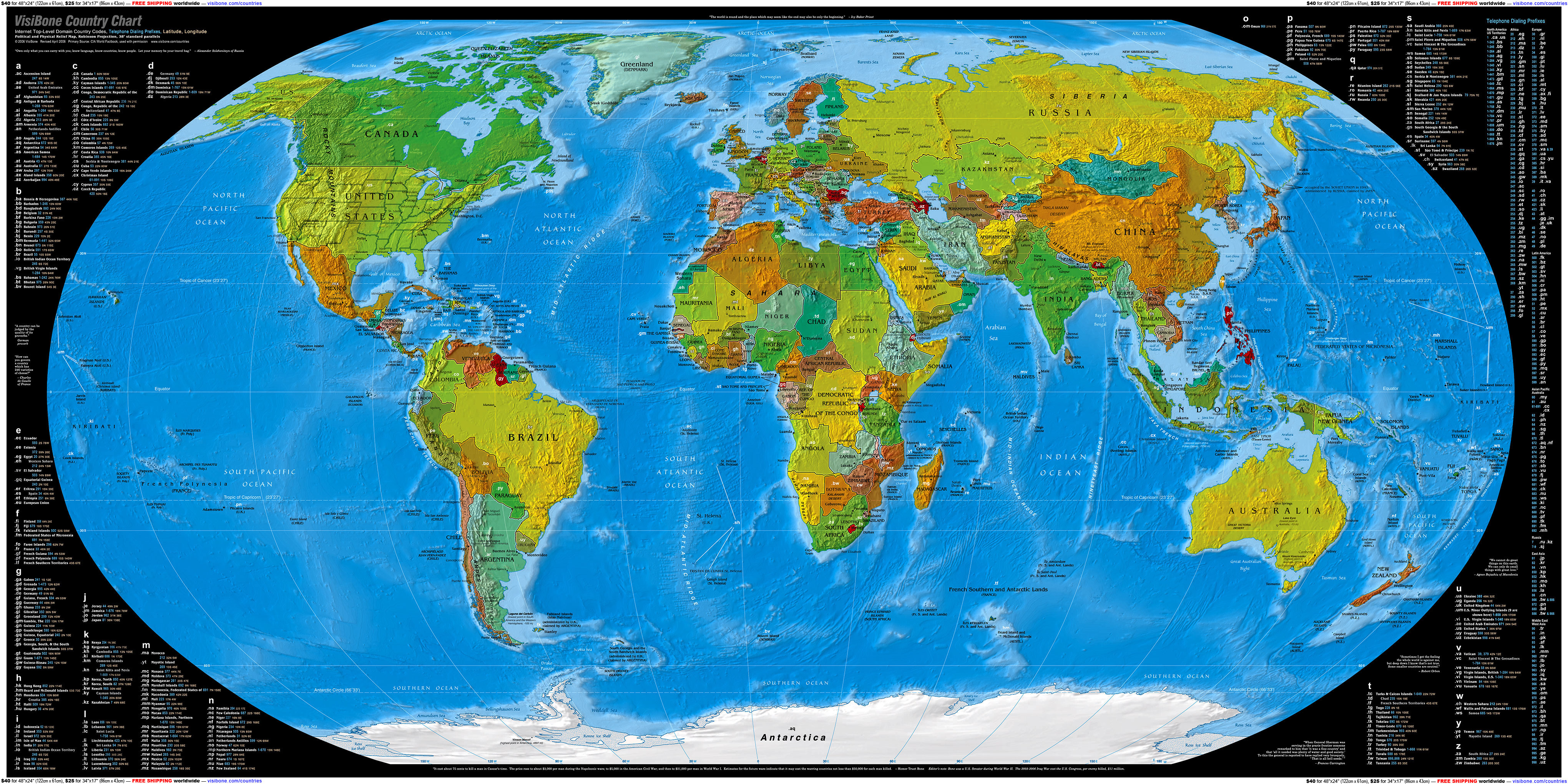
New 2008 Edition (history of the VisiBone Country Chart).
![]() Labels:
Map
at
9:39 AM
0
comments
Labels:
Map
at
9:39 AM
0
comments
Shrinking of Arctic Ice Pole
1 October 2007
Arctic Sea Ice Shatters All Previous Record Lows
Diminished summer sea ice leads to opening of the fabled Northwest Passage
This is a press release from the National Snow and Ice Data Center (NSIDC), which is part of the Cooperative Institute for Research in Environmental Sciences at the University of Colorado at Boulder.
Media Relations Contact:Stephanie Renfrow, NSIDC: srenfrow@nsidc.org or +1 303 492-1497 (se habla Español)
Data: from MODIS satellite. Credit: National Snow and Ice Data Center.
Arctic sea ice during the 2007 melt season plummeted to the lowest levels since satellite measurements began in 1979. The average sea ice extent for the month of September was 4.28 million square kilometers (1.65 million square miles), the lowest September on record, shattering the previous record for the month, set in 2005, by 23 percent (see Figure 1). At the end of the melt season, September 2007 sea ice was 39 percent below the long-term average from 1979 to 2000 (see Figure 2). If ship and aircraft records from before the satellite era are taken into account, sea ice may have fallen by as much as 50 percent from the 1950s. The September rate of sea ice decline since 1979 is now approximately 10 percent per decade, or 72,000 square kilometers (28,000 square miles) per year (see Figure 3).

Figure 1: This image compares the average sea ice extent for September 2007 to September 2005; the magenta line indicates the long-term median from 1979 to 2000. September 2007 sea ice extent was 4.28 million square kilometers (1.65 million square miles), compared to 5.57 million square kilometers (2.14 million square miles) in September 2005. This image is from the NSIDC Sea Ice Index. See high-resolution version
From National Oceanic and Atmospheric Administration




![]() Labels:
Geography,
Global warming,
icebergs,
the Arctic
at
8:52 AM
0
comments
Labels:
Geography,
Global warming,
icebergs,
the Arctic
at
8:52 AM
0
comments
3/23/2008
Permafrost regions in Russia
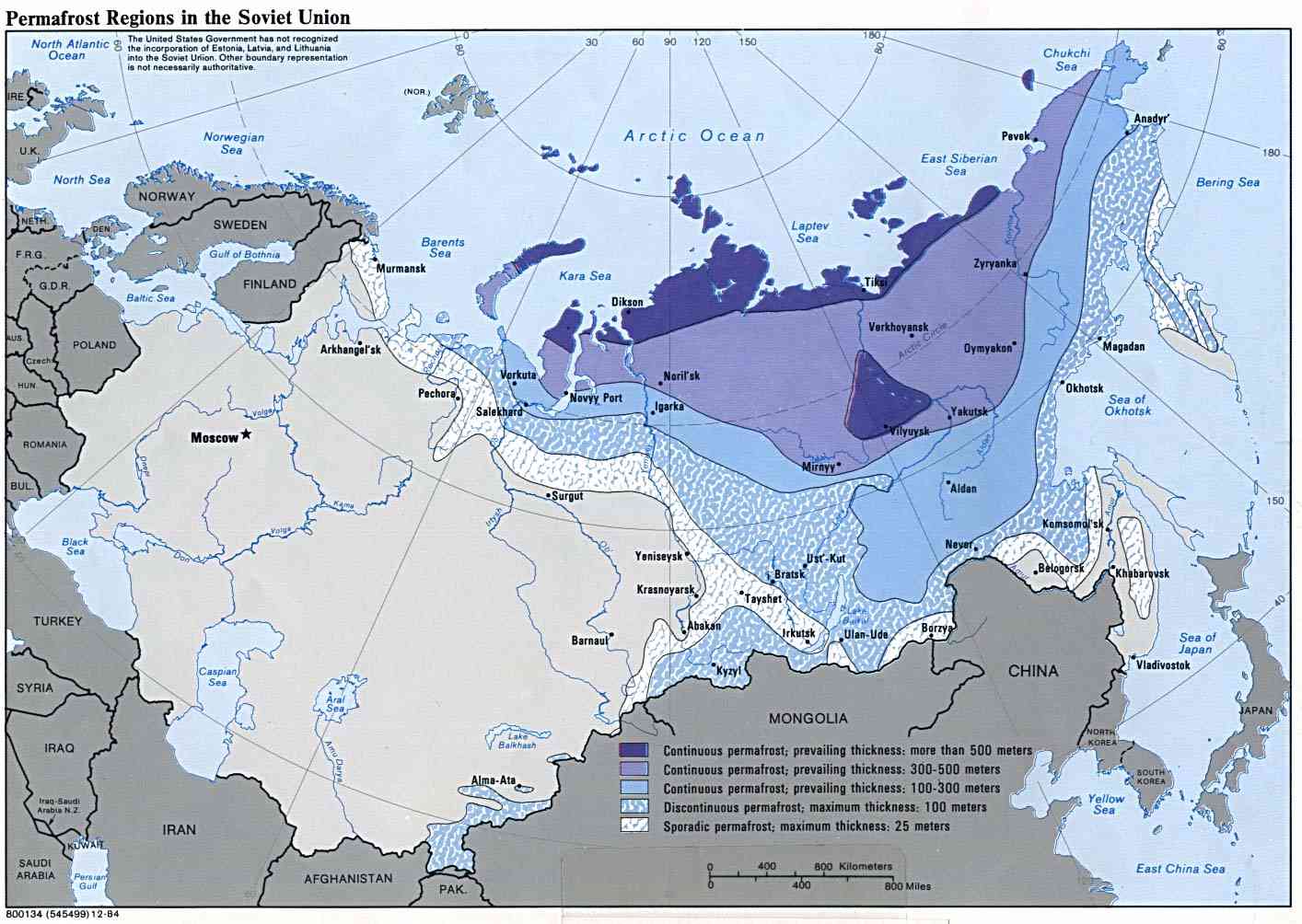 Continuous permafrost, prevailing thickness: more than 500 meters
Continuous permafrost, prevailing thickness: more than 500 meters
Continuous permafrost, prevailing thickness: 300 - 500 meters
Continuous permafrost, prevailing thickness: 100 - 300 meters
Discontinuous permafrost, max thickness: 100 meters
Sporadic permafrost: max thickness: 25 meters
http://www.grandpoohbah.net/Grandpoohbah/images/ArcticRus.jpg
![]() Labels:
icebergs,
Map,
Russia,
the Arctic
at
11:25 AM
0
comments
Labels:
icebergs,
Map,
Russia,
the Arctic
at
11:25 AM
0
comments
3/22/2008
Novaya Zemlya
 From CNN 1997 issue.
From CNN 1997 issue.
Novaya Zemlya (Russian: Но́вая Земля́, lit. New Land; formerly known in English and still in Dutch as Nova Zembla) is an archipelago in the Arctic Ocean in the north of Russia and the extreme northeast of Europe at Cape Zhelaniya (see also extreme points of Europe).
The archipelago is administered by Arkhangelsk Oblast as Novaya Zemlya Island Territory. Its population is 2,716 (2002 census), of which 2,622 reside in Belushya Guba, an urban-type settlement that is the administrative center of Novaya Zemlya District. The indigenous population consists of about 100 Nenetses and 50 Avars[citation needed] who subsist mainly on fishing, trapping, polar bear hunting, and seal hunting.[1]
 (* Author: Øyvind Ravna ** first uploaded to Wikipedia )
(* Author: Øyvind Ravna ** first uploaded to Wikipedia )
In 1954, the Soviet Union established its largest nuclear testing grounds at Novaya Zemlya.[1,2].
Code Name: Joe-17
Time and Date: 06:33 September 21, 1955 (GMT)
Location: Zone A, Guba Chernaya, Novaya Zemlya
Height: -32 feet
Type: Underwater Burst
Predicted Yield: ---
Actual Yield: 3.5 kilotons
From 1955 to 1990, the Soviet Union conducted 130 nuclear tests--88 atmospheric, 39 underground, and 3 underwater tests. The Soviet Union/Russia has not conducted a nuclear test since 24 October 1990.[1,2] A nuclear test moratorium was initially announced by President Gorbachev in October 1991.
During the testing program, the Soviet Union conducted tests at different sites in several zones, the numbers and designations of which frequently changed.[3] Most of the testing was consolidated in three zones at Novaya Zemlya.
At Zone A in the Chernaya Gulf region, low- and medium-yield atmospheric explosions, and underwater and surface nuclear tests were staged from 1955-1962. After 1963, six underground tests were staged.[3]
From 1964 through 1990, nuclear tests were conducted in deep underground shafts in Zone B on the Gulf of Matochkin Shar's southern bank.[2,3] Zone B also houses the test site's administrative and scientific center.[3]
Zone C, where atmospheric tests were conducted from 1957 through 1962, is located on Sukhoy Nos peninsula, north of Matochkin Shar strait.
The King of Bomb on Sukhoy Nos Peninsula 
Code Name: "Big Ivan" (Tsar Bomba)
Time and Date: 11:32 AM October 30, 1961 (Moscow Time)
Location: D-2 Sector, Zone C, Sukhoy Nos Peninsula,Novaya Zemlya, Russia
Height: 12800 feet
Type: Air Burst - Air Drop
Predicted Yield: ~50000 kilotons
Actual Yield: 50000 kilotons
Panaromic view of the site a few days after the blast. The peninsula was reported by an eyewitness to be "swept clean," with the landscape having a melted, glassy look.

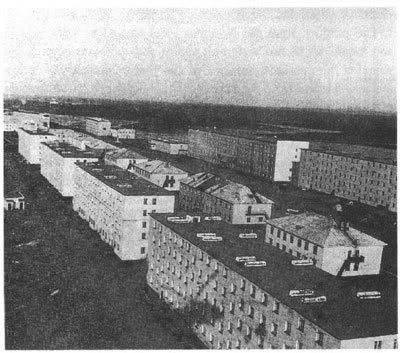
Belushiya, HQ of Northern test site, c. 1970s. Illustration from I Am a Hawk.
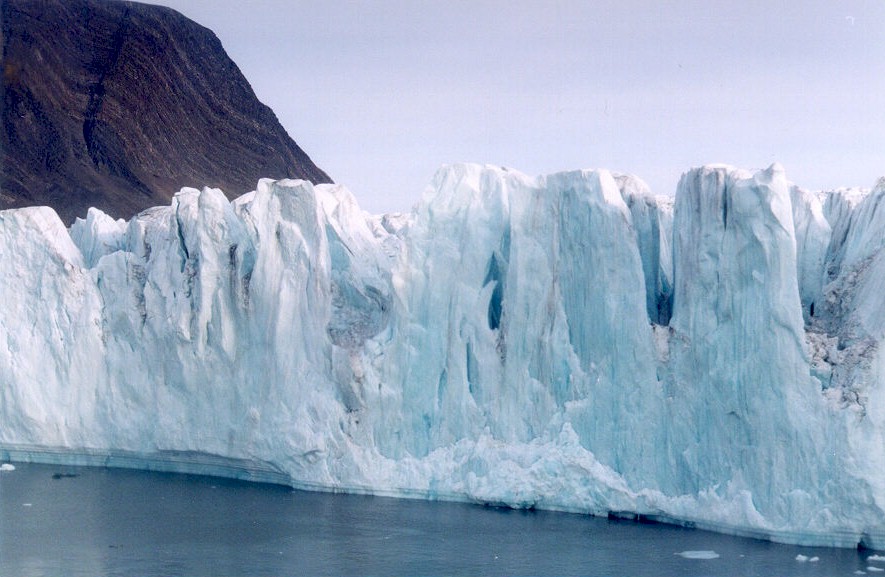 North Island Glacia
North Island Glacia
In February 1992, President Boris Yeltsin signed the decree On the Test Site at Novaya Zemlya, designating the official name of the site as the Central Test Site of the Russian Federation.
Over its entire history as a nuclear test site, Novaya Zemlya hosted 224
nuclear detonations with a total explosive energy equivalent to 265 megatons of
TNT.[12]
For comparison, all explosives used in World War II, including the detonations of two U.S. nuclear bombs, amounted to only two megatons.[13]
Sources: [1]Atompressa, No. 32, September 1999, p. 4. [2] Vadim A. Logachev and Antoliy M. Matushchenko, "The Current Impact of Past Nuclear Testing on Novaya Zemlya," Russian Conservation News, No. 22, Winter/Spring 2000, p.23. [3] (Moscow: IzdAT, 2000), pp. 75.-78. {Entered 7/27/00 SS}
Further details: The radiological situation on Novaya Zemlya (2002)
Novaya Zemlya taken by David Lubinski in 2001

Russia conducts hydrodynamic or subcritical tests at the country's only remaining internal test site, which is located on the Gulf of Matochkin Shar. Using hydrodynamic tests, scientists examine the fissile materials in stockpiled nuclear munitions to study the service life, reliability and safety of the munitions.[6] Russia staged seven non-nuclear explosions in 1999 and one subcritical test in January 2000.[7] (For details, see development from 30 May 2000 below.) (See also the entries under Russia: Treaties: CTBT and Nuclear Testing Developments.)
Sources: [6] Dmitriy Litovkin, Krasnaya zvezda, 21 August 1999, p. 4. {Updated 5/31/00 SS} [7] Anna Bazhenova, ITAR-TASS, 30 May 2000; in "Russia to Continue Experiments with Non-Nuclear Explosions," FBIS Document CEP20000530000055.
Apart from nuclear tests, the Novaya Zemlya test site has been evaluated as a site for a range of other activities, including nuclear waste storage. For more than a decade, Russia has been considering the storage of low-, medium-, and high-level radioactive waste, as well as spent fuel and nuclear reactors from nuclear submarines, on Novaya Zemlya. The first plans, for the storage of low- and medium-radioactive waste, including cesium and cobalt, were developed in 1991 by the All-Russian Scientific Research and Design Institute of Industrial Technology (VNIPI Promtekhnologii) and the All-Russian Scientific Research and Design Institute of Energy Technology (VNIPIET).
A site on the south of the southern island, north of Bashmachnaya Bay, was selected, and construction of the storage site included in the special federal program "On the Treatment of Radioactive Waste and Spent Nuclear Materials, Their Recycling, and Their Disposal from 1996-2005."[1,2,3,4] According to current plans, the facility will house radioactive waste from Northern Fleet nuclear-powered submarines in addition to waste in temporary storage at the Mironova Gora site near Severodvinsk, Arkhangelsk Oblast.
 Novaya Zemlya from Siku News
Novaya Zemlya from Siku News Public hearings regarding construction of the facility were carried out in 2001, and a positive environmental impact assessment was completed in March 2002. Construction will cost an estimated $73 million and take three to four years.[5] Russian environmental groups are protesting against the facility, saying that spending levels are too low to implement adequate safety measures, and that Novaya Zemlya lacks the infrastructure for constant radiation monitoring.[6]A large solid radioactive waste and spent nuclear fuel storage facility may also be built on Novaya Zemlya.
Novaya Zemlya taken by David Lubinski in 2001

By May 2001, five 300-meter test shafts had already been drilled to test radioactive waste and spent nuclear fuel burying technologies.[7] The waste would be stored underground in cement-lined shafts that are 90 meters deep. Novaya Zemlya was chosen because of its permafrost conditions: groundwater can be found only at a depth of 600 meters. According to Nikolay Lobanov, scientific head of the project, the shafts can withstand a 150-megaton (MT) nuclear explosion and a 7.0 earthquake.[8] The project has been ordered by Atomredmetzoloto, and a design drafted by VNIPI Promtekhnologii; its main subcontractors are VNIPIET and Gidrospetsgeologiya.[5,9] The facility’s projected capacity is 50,000 cubic meters.
An international consortium, consisting of Deutsche Gesellschaft zum Bau und Betrieb von Endlagern fuer Abfallstoffe mbH (Germany), Gesellschaft fuer Anlagen- und Reaktorsicherheit mbH (Germany), Posiva Oy (Finland), AEA Technology (United Kingdom), Institutt for energi teknikk (Norway), and Svensk Kaernbraenslehantering AB (Sweden), is assessing the project's safety.[7] Environmentalists oppose the plan due to safety concerns and fears that imported spent nuclear fuel may eventually be stored at the site.
Arkhangelsk Governor Anatoliy Yefremov has denied this, saying that all wastes will originate in northwest Russia.[6]Another proposal for dealing with the problem of spent fuel, nuclear reactors, and radioactive waste from nuclear-powered submarines involves the use of underground nuclear explosions to vitrify the spent fuel and radioactive waste in tunnels at the Central Atomic Test Site on Novaya Zemlya. The proposal, first introduced in 1994, soon met with opposition over the possibility that the explosions might violate the CTBT.
Nevertheless, at the request of then-president Boris Yeltsin, the Central Physical-Technical Institute (TsFTI) in Sergiyev Posad developed techniques for implementing the project, which never came to fruition.[10] In June 1999, TsFTI Chief Scientific Associate Leonid Yevterev and several other scientists published an article in Nezavisimoye voyennoye obozreniye, again making an argument for the implementation of their plan.[11]
The Karsk and Laptev Seas

In the Karsk Sea 11000 containers with radioactive waste are buried. They are located in 15 regions of the basins of the seas.
Sources:[1] Russian Ministry of Natural Resources Web Site, http://www.mnr.gov.ru/index.php?8+2+&glava=37.[2] M. Kondratkova, “Novaya Zemlya: Unexpected View on Possibility of Use,” Atompressa, No. 13, April 1999; in “Use of Novaya Zemlya for Radwaste Storage,” FBIS Document FTS19990602001203.[3] “Yadernyy mogilnik na Novoy Zemle?” Volna, 14 April 1998, p. 7.[4] “Na arkhipelage Novaya Zemlya planiruyetsya postroit khranilishche yadernykh otkhodov,” Interfax, 5 July 2001.[5] Nuclear.ru Web Site, http://www.nuclear.ru/, 23 May 2002.[6] “Russian Environmentalists Opposed to Nuclear Waste Burial on Arctic Archipelago,” Interfax, 27 May 2002.[7] Ivan Moseyev, “‘Mogilnyy’ proyekt dostalsya Arkhangelsku,” Delovoy Peterburg, May 22, 2001, p.7; in WPS Yadernyye materialy, No. 22, 8 June 2001.[8] Nadezhda Breshkovskaya, Pravda Severa, February 20, 2001; in WPS Yadernyye materialy, No. 12, 23 March 2001.[9] Nuclear.ru Web Site, http://www.nuclear.ru/, 8 February 2002.[10] Viktor Litovkin, Izvestiya, 6 May 1997, p. 5.[11] Leonid Yevterev, Nezavisimoye voyennoye obozreniye, No. 23, 18-24 June 1999, p. 5. {Updated 5/28/2002 CC}
Berents Sea on the westcoast of Novaya Zemlya
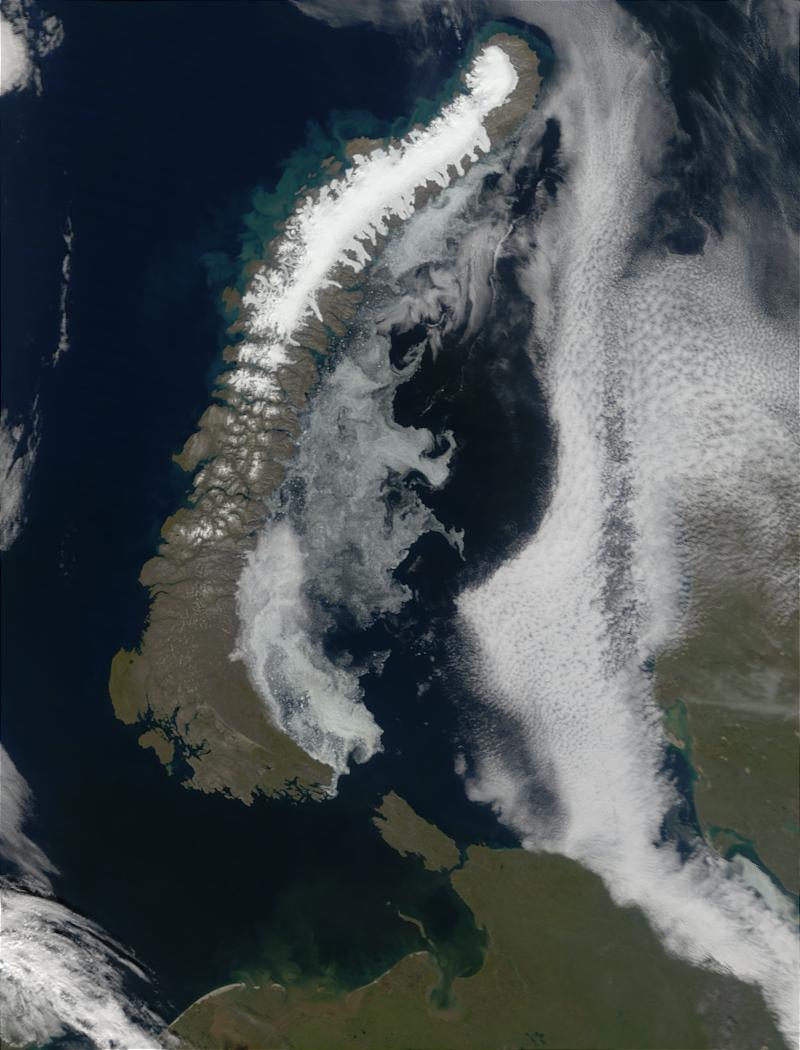
The blue-green swirls in the waters of the Barents Sea could indicate a bloom of phytoplankton, or they could be highly reflective glacial silt resulting from run off.
On 30 June 2002, after his joint trip with Defense Minister Sergey Ivanov to the Novaya Zemlya archipelago, Minister of Atomic Energy Aleksandr Rumyantsev told ITAR-TASS that maintaining the Central Test Site of the Russian Federation on Novaya Zemlya was a matter of national security and necessary to maintain Russia's status as a nuclear state. He said that nuclear testing may well resume in future in response to political developments elsewhere in the world.[1] According to Sergey Ivanov, who inspected the security arrangements at the testing ground, Russia has no plans to resume full-scale nuclear testing but intends to maintain and upgrade the existing testing infrastructure.[2]
 Arctic expedition 2006 passing by Novaya Zemlya. The first land seen since leaving Kirkenes.
Arctic expedition 2006 passing by Novaya Zemlya. The first land seen since leaving Kirkenes.Sources: [1] Aleksey Kravchenko, Vladimir Rogachev, "Glava Minatoma Rossii ne isklyuchayet teoreticheskuyu vozmozhnost vozobnovleniya yadernykh ispytaniy," ITAR-TASS, http://www.itar-tass.com/, 30 June 2002; in Integrum online database, http://www.integrum.com/.[2] Dmitriy Safonov, "Materik osvobozhdayut ot yadernykh otkhodov," Izvestiya online edition, http://www.izvestia.ru, 27 June 2002. {Entered 8/19/2002 DA}
Sunset by Gunther Kletetschka, April 2001, Novaya Zemlya.
"The rectangle sun", "the line", "the double sunset", the polar sunset
Gerrit de Veer, the first observer who recorded the Novaya Zemlya effect on 24 Jan. 1597.
"Charles T. Beke's introduction to the first (1853) edition (printed here in the
second edition on pp. cxliv - clvi), showing that de Veer's observations are
reliable. He concludes that "We have therefore no alternative but to receive the
facts recorded by de Veer as substantially true, and to believe that
owing to the peculiar condition of the atmosphere, there existed an extraordinary
refraction, not merely on the 25th of January,but continuously during 14
days afterwards, at first amounting to nearly four degrees, but gradually
decreasing to about one degree and a half."

Mathematically provable, the sun becomes very close to a horizontal line. Refraction of the lower limb exceeds the sun diameter and the sun's upper limb refraction boost. Becoming now exceedingly thin makes the line appear jagged, the same as stars twinkling due to turbulence in the atmosphere. The line appears orange to red.
新地島. Novaya Zemlya. 俄羅斯西北部群島。位於北冰洋,介於巴倫支海與喀拉(Kara)海之間。新地島主要由南、北兩大島組成 -- 大英百科全書線上繁體中文版
![]() Labels:
Distant places,
Geography,
Nuclear testing,
the Arctic,
travelling
at
2:16 PM
0
comments
Labels:
Distant places,
Geography,
Nuclear testing,
the Arctic,
travelling
at
2:16 PM
0
comments
3/16/2008
My Birthday wish ~.~
Video Features Sand artistic Illana Yahav, Music by Merav Josef-Levy, Saxophone played by Tevet Sela www.sandfantasy.com
~ . ~ A birthday Rose to me from God's child ~ . ~
Pray for Cedar Fund's work on children with AIDS in Lesotho through a local church.
Lesotho is a small country surrounded by South Africa.
It's on a mountain and about 30% of the population has aids. Cedar Fund has been funding a Girl's school & boarding project started by a Chrisitian couple in liaison with local church. My friend & her husband led a team of 8 to visit Lesotho on behalf of Cedar 4 Mar - 12 Mar 2008.
~~~~~~~~~
My Birthday wish
God's work be done in my family, my colleagues as it is in heaven.
I conceive to do Alpha Course in my Faculty Lab Block in Mar 08. Start with my continued prayer for my Brother to participate and be touched by Our Almighty Triune God.
A Dream... A long prayer....
Alpha Course
for scientists, geneticists, medical researchers, lab technicians,
awe of God's creation.
Pray for its persistence, spiritual guidance, union of spiritual hearts
.
![]() Labels:
Evangelism,
missiology,
My birthday,
My lifelong partner,
office,
Prayer,
Video
at
9:05 PM
0
comments
Labels:
Evangelism,
missiology,
My birthday,
My lifelong partner,
office,
Prayer,
Video
at
9:05 PM
0
comments











